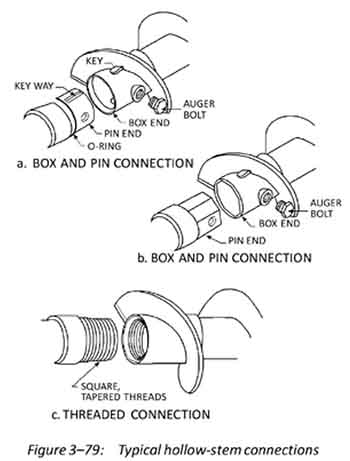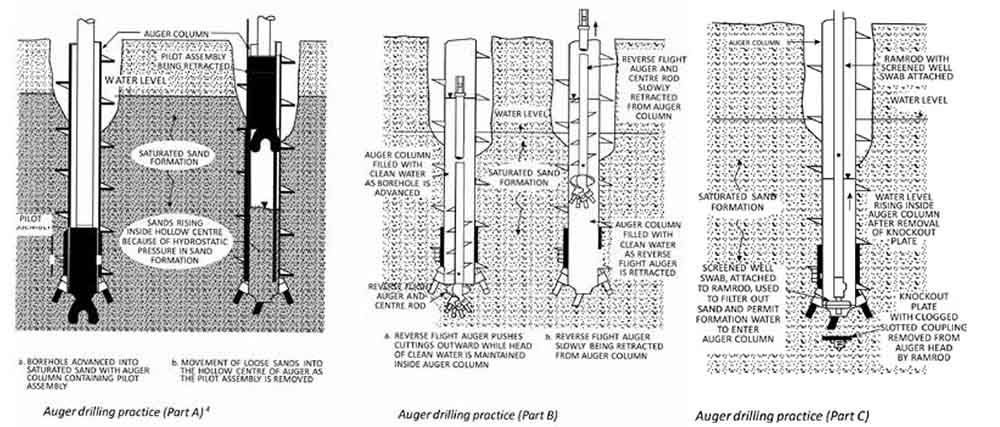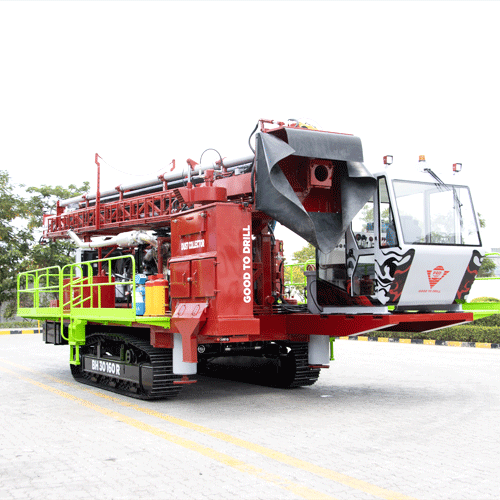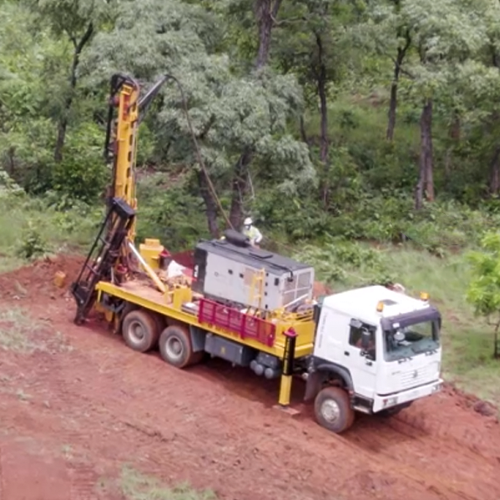Technical Corner Auger Drilling Practice
The drill string and bits
– Hole making and clearing
– Overcoming hole-making problems
– Recognising what is happening
THE DRILL STRING AND BITS
Auger rigs use two types of drill strings:
– Continuous auger flight: The flights with internal rod tools are themselves the complete string.
– Short flight or bucket: The auger tools are driven by a solid rod string.
The auger drilling system is unique in that it is operated almost exclusively in unconsolidated or friable formations. It uses drag bits of many different shapes and cutting angles

Continuous flight auger bits
Continuous flight auger bits come in two basic configurations: either finger-type drag bits or ‘vee’ bits. The vee bit is designed to ‘refuse’ on moderately weathered bedrock, and as such is used extensively in site investigation drilling.
The teeth of the bit heads may be hard steel, hard- faced, or fitted with carbide inserts. Carbide-type bits can drill competently in shale, sandstone, and some limestones, and are usually preferred for all round use where boulders are encountered. The teeth on cutter head bits are replaceable. This is convenient, as they can be knocked off when boulders are encountered.
Flights and flight connections
The continuous flights themselves are usually supplied in 1.5 m (5 ft) lengths to fit most machines and for ease of handling because of their heavy construction. When joined together, the flights form a convoy system to move cuttings from the cutter head to the surface.
The pitch of the spiral flighting is preselected by the manufacturer and is designed to lift cuttings easily. Generally, the lesser the pitch, the better the lifting capacity.
Commonly, the pitch for vertical boring is less than the flight diameter by about 60% to 80% (e.g. 4 inch flights have a 2 or 3 inch pitch).
Connections are pin-and-socket or pin-and-box styles, or sometimes threaded. The flights are secured either by friction bolts in the box end or driven ‘D’ pins. Figure 3–79 shows three typical hollow-stem connections.

HOLE MAKING AND CLEARING
In practice, the use of continuous flight augers (including hollow-stem augers), is fairly straightforward. The entire string is rotated downward, fed downward by the torque of the rotating head. Holdback is important in hole clearing.
The hole may be advanced continuously to a specific target by connecting and feeding 1.5 m (5 ft) sections, or it may be advanced and then cleared and stopped for sampling at 1.5 m (5 ft) (or other) intervals or at any evidence of strata change.
Hollow stem augers may be advanced with the entire assembly, as illustrated above. They may also be advanced without the internal rod, using a knock out plug in the lead flight. This is usually expedient in drilling and sampling where heaving is not a problem, saving the step of removing rods to install casing or sampling devices.
Recent advances in hollow auger design use a wireline system, similar in many ways to the wireline coring system, rather than an internal rod string.
The standard drag-type bit used for normal auger drilling can be removed at any stage using a wire line overshot recovery tool. Tests such as SPT can then be carried out inside the hollow auger string, or a stationary sampling (inner) tube can be lowered and locked into position on the wire line, enabling a disturbed ‘core’ of the soil profile to be obtained.
In auger drilling, the hole-making forces blend with hole-cleaning forces because they are both provided by rotary torque.
Making cuttings: The cutting, shearing, or tearing action is achieved using high rotary torques. In the larger sizes and in more compact formations, very high thrusts are used to keep the bit penetrating.
Chip clearing: Chips are cleared mechanically with the cutting forces providing the impetus. That is, the chip cut last is pushed away from the bottom and across the cutting edge by the chips being cut next. This clearing action thus draws energy from both the rotary and thrust drives.
OVERCOMING HOLE-MAKING PROBLEMS
Screw in: Hole-making forces are sometimes so great as to cause ‘pull in’, that is, the flight is screwed into the ground instead of advancing the hole. The driller must apply holdback rather than thrust to make the bit feed properly.
If sufficient holdback is not used, the auger string will ‘screw-in’ until the holdback required to reverse the situation is beyond the capacity of the (usually lightweight) machine. It can advance far enough that the augers become ‘planted’, that is, so thoroughly screwed in that pullback and hoisting cannot dislodge them.
When augers screw in, rotation can be reversed briefly to unscrew the bit and clear the cuttings. The bit can then be fed again with sufficient holdback.
Reversing rotation should be attempted only with flights that are secured by pins or bolts, or the flights downhole will unscrew. The security of pins and bolts should be tested before sending a new flight down.
Boulders and hard zones: Boulders and isolated zones of harder rock often cause refusal when using drag or cutter head bits. Grinding away with increased feed may do the job; however, watch for deviation.
When using hollow flight augers, another approach is to run a small tricone rock bit on the internal rods. The tricone bit can then be fed with pull-down and circulation if necessary to penetrate or break small boulders or hard rock zones. Normal operations may then be resumed.
Heaving sands: Many references usually state flatly that augering is impractical below the water table.
Since it is used widely in a groundwater monitoring well installation, this is probably not the case, but pressurised, loose saturated sands (heaving sands) can pose a special problem. In this case, if an internal rod is withdrawn or a plug is knocked out, the loose sand, under hydrostatic pressure, moves into the auger. This may lock the auger, or at least require bailing or re-drilling. Bailing may make it worse by creating suction that draws in more sand.
Several techniques can counteract heaving effects and permit hole advancement through such zones:
- Knockout plug: Keeps the sand out temporarily, that is, long enough to drill through or place a casing. The major disadvantage is that it can be used only once. Another is the lack of information on the potentiometric level in the formation. A slotted plug permits water to enter the auger column, allowing measurement of the water level.
- Run internal rods: If you know where the zone is, you can keep the rods in place and drill through.
- Maintain a positive hydraulic head: If the head in the heaving sand is known or can be determined experimentally, a positive head can be maintained in the auger column.
This requires the capability to inject water through the auger head. A disadvantage in geochemical sampling programs is the alteration of in situ water quality.
Reverse-flight augers are used to run a smaller, reverse-flight auger inside the hollow-stem column. The heaving sand is augered out through the lead auger back into the formation. A positive water head is maintained to help it along. To sample, the internal auger has to be withdrawn, and heaving can recur.
Run a swab on the internal rods: An ordinary small diameter development swab can be used for much the same purpose. Installed at the bit face, it keeps sand out. It can be withdrawn to sample, then used to push sand back out.
Flexible centre plug: This reusable plug overcomes the one-shot nature of drive out plugs and the piston effect of other internal devices. It permits sampling out through the auger column, then closes again to hold out heaving sand.
RECOGNISING WHAT IS HAPPENING
Torque and feel are important indicators of downhole conditions. Increased torque is an indication of extra power required downhole, as in hard drilling. Slow penetration and ‘chatter’ or ‘bounce’ are also indications that boulders or hard zones are encountered. The driller then determines by feel and experimentation how to proceed.
When a hard zone or object is encountered, the driller can increase bit thrust and observe the result. If the bit cuts without deviation, penetration can proceed.
If torque builds, a sideways force is building that can cause deviation. The driller should attempt to clear the hole and then recheck the torque.
Auger drilling is frequently used for site investigation drilling. When operated with a careful feeling for thrust and torque applied, the driller’s record becomes a reliable statement of variations in subsurface conditions.
Changes in the degree of saturation of the formation can cause large differences in the drilling forces. The driller’s record must include information on moisture content.
Auger drilling functions and uses are further described in Chapter 8, particularly in environmental drilling and sampling.






